Information briefs for the week check out AMRs readying to tackle Antarctic chilly, John Deere’s transfer into precision farming with ExactShot autonomous planter, Cobalt Robotics fielding safety patrols for Johnson Controls’ mega-size properties, and specialised cobot arm with glass finish effector is a breakthrough improve for biopsies and different subdermal procedures.

Cellular robotic takes on excessive chilly
Winter arrives in August for Antarctica, the place temperatures at distant components of the excessive plateau could repeatedly drop under -90°C (-130°F). Summer time begins in January for Antarctica, the place the times common 6° C (43°F). Downright balmy.
Can autonomous cell robots (AMRs) function in such extremes of climate? An AMR appropriately named Ice Dice was constructed to search out out. As a take a look at observe, the newly-launched Ice Dice is being examined within the Norwegian Arctic, the place in Karasjok winter temperatures (in January) have slumped as little as −51.4 °C (−60.5 °F).
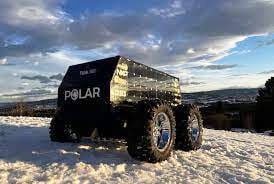 It is definitely not the extremes of Antarctica, however nonetheless mighty chilly. The typical human can solely survive -49 levels F (-45 levels C) for about thirty minutes. Therefore, an enormous purpose why an AMR like Ice Dice is so necessary.
It is definitely not the extremes of Antarctica, however nonetheless mighty chilly. The typical human can solely survive -49 levels F (-45 levels C) for about thirty minutes. Therefore, an enormous purpose why an AMR like Ice Dice is so necessary.
“We will take a look at numerous issues in our lab, however not how the rover drives within the snow, how the photo voltaic panels deal with the snow and temperatures, and the way chilly it would get contained in the rover and the way shortly it turns into very chilly,” explains group supervisor Laurenz Edelmann of Eindhoven College of Know-how within the Netherlands, the place Ice Dice was constructed.
Staff Polar, as Edelmann’s group known as, wish to create an alternate method to do in depth environmental analysis within the coldest locations on our planet by growing an unmanned rover.
The group started researching and constructing in 2018, and now, 4 years on, has its first working prototype working in Trondheim, Norway. Winter: -15.0°F (-26.1°C).
In response to Staff Polar: “Earth is dealing with its greatest downside in centuries: local weather change. To fight it, we have to higher perceive the components behind local weather change. It’s then vital to gather details about our planet in locations the place nature remains to be pristine, and roughly untouched by local weather change.”
ExactShot saves work, cash, and the surroundings
When planting, starter fertilizer is crucial in making new seedings flourish. Nevertheless, farmers use an excessive amount of when making use of a steady circulate of fertilizer to the complete row of seeds. John Deere’s newly-released ExactShot is a robotics-based fertilizer system that 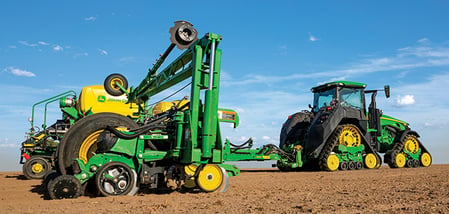 applies solely exact quantities of starter.
applies solely exact quantities of starter.
“What ExactShot allows us to do is definitely ship starter fertilizer precisely the place the seed is at,” says Madelyn Koester, senior product supervisor and soil well being lead at John Deere. “We truly cut back our fertilizer software by about 60% with this new system, which has enormous value financial savings for the farmer, but in addition has an enormous environmental impression, as a result of we’re placing that a lot much less fertilizer out, which reduces the probabilities for runoff and different issues which might be negatively impacting the surroundings.”
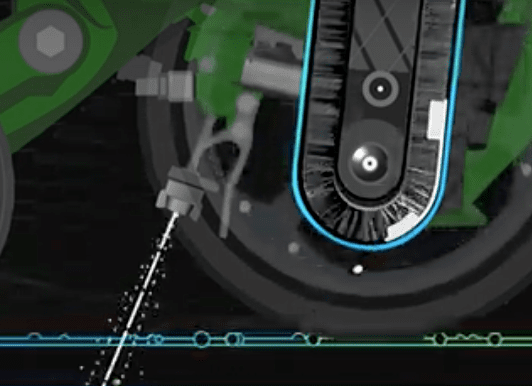 The important thing to the system: ExactShot know-how makes use of sensors and robotics to ship out timed bursts of fertilizer that coat particular person seeds, leaving the areas between them fertilizer-free. (see video)
The important thing to the system: ExactShot know-how makes use of sensors and robotics to ship out timed bursts of fertilizer that coat particular person seeds, leaving the areas between them fertilizer-free. (see video)
“Precision is vital in agriculture as a result of we’re working in enormous portions of acres and vegetation per acre,” mentioned Deanna Kovar, John Deere’s vp of manufacturing and precision agriculture manufacturing techniques. “Ultimately, we are going to actually deal with each plant on an acre of a area in a different way based mostly on what we’re studying by our laptop imaginative and prescient and machine-learning tech.”
Cobot arm spurs improvement of glass finish effector
The medical hypodermic needle, used over 16 billion occasions yearly, has not modified in 150 years. Piercing the pores and skin and both 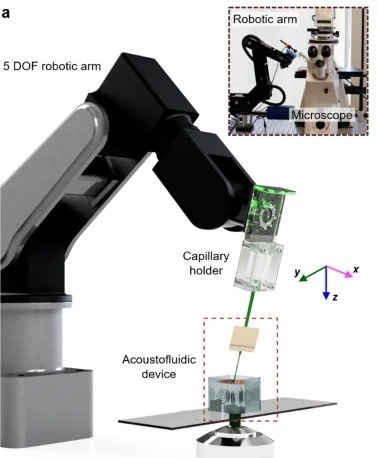 injecting or withdrawing physique fluids is its main operate. Nevertheless, the system has confirmed itself to be inefficient when used for biopsy, which is a “process to take away a chunk of tissue or a pattern of cells from a physique in order that it may be examined in a laboratory.”
injecting or withdrawing physique fluids is its main operate. Nevertheless, the system has confirmed itself to be inefficient when used for biopsy, which is a “process to take away a chunk of tissue or a pattern of cells from a physique in order that it may be examined in a laboratory.”
For biopsies, when the hypodermic needle is used to supply histological and molecular tissue samples, as much as 34% of histological and as much as 50% molecular assessments fail or the harvests present inadequate pattern portions.
In a breakthrough for microfluidics, scientists at ETH Zurich (Switzerland) have developed a skinny glass needle (finish effector) that may be affixed to a novel cobot arm with 5-DoF. Ultrasonic oscillations of the glass needle permit medical personnel to pump and blend small quantities of liquid and entice particles for biopsies that in any other case can be inadequate for testing. Particles transfer towards the oscillating glass needle, the place they have an inclination to build up.
ETH Professor Daniel Ahmed and his group are presently “integrating conventional microfluidics and robotics.” Making use of ultrasound, the system is “perfect for executing an in depth vary of duties in microfluidic and micro-robotic functions.”
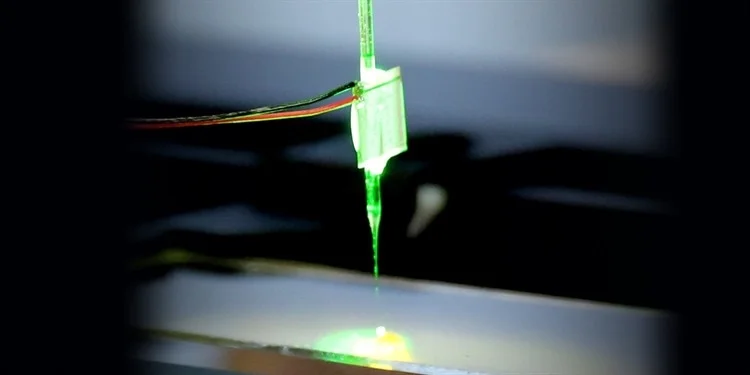
Cobalt’s robotic guards on the job at Johnson Controls
Johnson Controls’ company actual property division, International WorkPlace Options (GWS), manages 1.2 billion sq. toes of facility area (430 sq. miles). That’s an area virtually as giant because the land space of Los Angeles, CA (469 sq. miles).
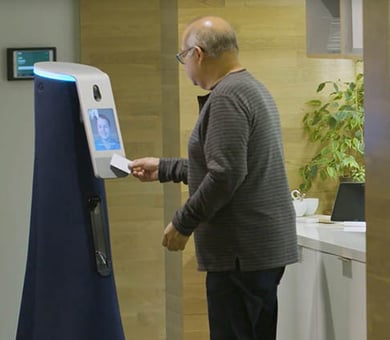 Patrolling and usually offering a safety perimeter for GWS is a formidable enterprise. Safety Gross sales & Integration’s Jason Knot writes about one of many latest tendencies in facility safety: “Dispatching AI robots from state-of the-art safety alarms goes to be the way forward for securing buildings in a a lot smarter, extra cost-efficient manner.” Such dispatching is precisely the character of the settlement between GWS and Fremont, CA-based Cobalt Robotics, “a machine-learning firm that automates repetitive handbook safety and facility duties with autonomous robots.”
Patrolling and usually offering a safety perimeter for GWS is a formidable enterprise. Safety Gross sales & Integration’s Jason Knot writes about one of many latest tendencies in facility safety: “Dispatching AI robots from state-of the-art safety alarms goes to be the way forward for securing buildings in a a lot smarter, extra cost-efficient manner.” Such dispatching is precisely the character of the settlement between GWS and Fremont, CA-based Cobalt Robotics, “a machine-learning firm that automates repetitive handbook safety and facility duties with autonomous robots.”
Johnson Controls C•CURE 9000 entry management and occasion administration system is now built-in with Cobalt’s distant robotic guard service, which incorporates AI, robotics, machine-learning software program, and human oversight.
Mike LeBlanc, president and COO of Cobalt, mentioned of the settlement: “The built-in Johnson Controls and Cobalt answer can automate responses to main safety incidents from breaches and break-ins to dangers like open doorways. With companies struggling to search out safety guards and maintain prices underneath management, this built-in system is the best way to automate alarm response at a considerably diminished value.”
“For a lot of of our clients, hiring costly safety guards throughout a troublesome labor scarcity isn’t an possibility,” mentioned Johnson Controls’ Rick Focke, director of product administration. “The safety workflow between our alarms and Cobalt’s robots is seamless, and all stories are routinely created and tracked so corporations could make facility enhancements over time.”
![]()





0 Comments